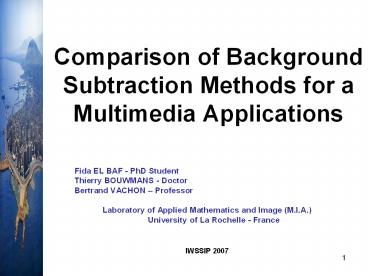Comparison of Background Subtraction Methods for a Multimedia Applications - PowerPoint PPT Presentation
Title:
Comparison of Background Subtraction Methods for a Multimedia Applications
Description:
Comparison of Background Subtraction Methods for a Multimedia Applications – PowerPoint PPT presentation
Number of Views:145
Title: Comparison of Background Subtraction Methods for a Multimedia Applications
1
Comparison of Background Subtraction Methods for
a Multimedia Applications
- Fida EL BAF - PhD Student
- Thierry BOUWMANS - Doctor
- Bertrand VACHON Professor
- Laboratory of Applied Mathematics and Image
(M.I.A.) - University of La Rochelle - France
- IWSSIP 2007
2
Summary
- Description of Aqu_at_thèque application
- Identification Three steps
- Educational information
- Virtual Representation
- Difficulties in Identification step
- Background Subtraction Methods
- Qualitative comparison
- Quantitative comparision
- Results
- Perspectives
3
Description of Aqu_at_thèque application
- Projection of the images acquired by a camera
movie directed to a tank - of an aquarium
- Appoint a fish by a visitor
- System of recognition of fish species
- System of behavioral modeling
4
Identification Three steps
- Segmentation Extraction of regions corresponding
to fishes in video sequences using a background
subtraction method (Ex Sliding Median) - Features extraction Color, texture, motion, etc
(24 features) - Classification of fishes using the extracted
features (Recognition ratio 92)
Background Image
Foreground Detection Mask
Current Image
5
Educational information
- Indexed pedagogic cards Pictures and real video
on the way of life, origin and the environment of
the selected animal (e.g preys, predators). - Example Pork fish
6
Virtual Representation
- Fishes can be represented in their real
environment with their prey and predators in a
virtual tank created by the user. - Technical innovation Behavior engine.
- Pedagogical interest Nature Stability
7
Difficulties in Identification step
- Bootstrapping
- Global or local illumination changes
- Crossing
- Camouflage
- Foreground aperture
- Occultation
8
Background Subtraction Methods
- Single Gaussian (SG) Wren, Medioni, Zhao
- Mixture of Gaussians (MOG) Stauffer
- Parametric, 3 5 Gaussians
- Kernel Density Estimation (KDE) Elgammal
- Non Parametric Complexity O(NN)
Pavlidis 2001 - I. Pavlidis, V. Morellas, P.
Tsiamyrtzs, S. Harp, Urban surveillance
systems from the laboratory to the commercial
world, Proceedings of the IEEE, volume 89, no.
10, pages 1478 -1497, 2001
9
Qualitative comparison of Background Subtraction
Methods
- Qualitative Performance Evaluation
- Time consuming and memory consuming
- Detection KDE, MOG, SG, Median, Mean
- Neglected algorithm KDE
10
Quantitative comparison of Background Subtraction
Methods
- Quantitative Performance Evaluation
- Let A be a detected region and B be the
corresponding ground truth, the similarity
between A and B is defined by Li as - It integrates the false positive and negative
errors (FPR, FNR) in one measure - Selected algorithm MOG offers the best
compromise Time consuming/Detection
SG MOG (5 gaussians) MOG (3 gaussians)
FPR 0.0005 0.0068 0.007
FNR 0.6419 0.4001 0.3683
Detection Rate 0.3580 0.5998 0.6317
S(A,B) 0.3564 0.5710 0.6004
11
Results of Detection
- Aquatheque sequence
a) b)
c) d) e)
a) Image 201, b) Groundthruth, c) SG Foreground
Mask, d) MOG Foreground Mask and e) KDE
Foreground Mask
12
Perspectives
- Future research
- Unified framework for background subtraction
- Evaluation of Background subtraction in the
context of Markerless Motion Capture system and
Video Surveillance. - Fuzzy model for background subtraction
(Imprecision, uncertainty)
13
Bibliography
- Aquathèque
- Semani al 2002 D.Semani, C. Saint-Jean, C.
Frélicot, T. Bouwmans, P. Courtellemont, Alive
Fish species characterization for on line
video-based recognition, Proceeding of the SPR
2002, Windsor, Canada, pages 689--698, January
2002 . - Semani al 2002 D. Semani, T. Bouwmans, C.
Frélicot, P. Courtellemont, Automatic Fish
Recognition in Interactive Live Videos,
Proceeding of the IVRCIA 2002, volume XIV,
Orlando, Florida, pages 94-99, July 2002. - Desfieux al 2002 J. Desfieux, L. Mascarilla,
P. Courtellemont, "Interactivity and Educational
Information in Virtual Real-Time 3D Videos",
Proceeding of the IVRCIA 2002, 2002. - Background Subtraction
- Wren 1997 C. Wren, A. Azarbayejani, T.
Darrell, A. Pentland, Pfinder Real-Time
Tracking of the Human Body, IEEE Transactions on
Pattern Analysis and Machine Intelligence, Volume
19, No. 7, pages 780 785 , July 1997. - Stauffer 1999 C. Stauffer, "Adaptive
background mixture models for real-time
tracking", Proceedings IEEE Conference on
Computer Vision and Pattern Recognition, pages
246-252, 1999. - Bowden al 2001 P. KaewTraKulPong, R. Bowden,
"An Improved Adaptive Background Mixture Model
for Real-time Tracking with Shadow Detection",
Proceedings 2nd European Workshop on Advanced
Video Based Surveillance Systems, AVBS 2001,
Kingston, UK, September 2001. - Elgammal 2000 A. Elgammal, Non-parametric
model for Background Subtraction, in
Proceedings of IEEE ICCV'99 FRAME RATE Workshop,
1999 - Bo Han 2004 B.Han, D. Comaniciu, L.Davis,
"Sequential kernel density approximation through
mode propagation applications to background
modeling, Proceeding Asian Conference on
Computer Vision (ACCV 2004), 2004. - Vasile Gui 2005 C. Ianasi, V. Gui, C. Toma, D.
Pescaru, A Fast Algorithm for Background
Tracking in Video Surveillance, Using Non
parametric Kernel Density Estimation, Facta
Universitatis, Series Electronics and
Energetics, volume 18, No. 1, pages 127-144,
April 2005. - Li al 2004 L. Li, W. Huang, I.Y.H. Gu,
Q. Tian, Statistical modeling of complex
backgrounds for foreground object detection,
IEEE Trans. Image Process, volume 13, pages
14591472, 2004. - Kim al 2006 K. Kim, T. Chalidabhongse, D.
Harwood, L. Davis, "PDR Performance Evaluation
Method for Foreground-Background Segmentation
Algorithms", EURASIP Journal on Applied Signal
Processing, 2006.































